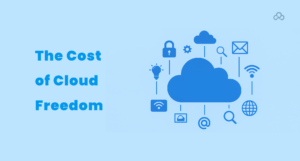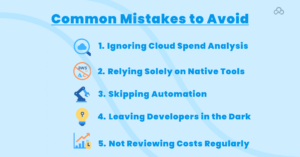The Cost of Cloud Freedom

Today Organizations are using multi-cloud strategies like never before. AWS, Azure, Google Cloud, and others offer the flexibility to choose the best-in-class service for every specific need. But with great power comes great complexity. Managing costs across different platforms can become a stress.
If you’re struggling with surprise invoices, lack of visibility, or rising costs across multiple cloud providers, you’re not alone. Multi-cloud billing is a real stress. And the good news? You can get the control using smart, proven cloud cost optimization strategies.
Why Multi-Cloud = Multi-Headache (Sometimes)
In theory, multi-cloud sounds like a smart move. Where you can reduce vendor lock-in, boost reliability, and choose services customized to specific workloads. But as cloud services grow, tracking costs becomes difficult.
Each cloud provider has its own billing formats, pricing models, and terminology. Even worse, engineering and finance teams often work separately. This makes cloud spend analysis difficult, error-prone, and time-consuming as well.
Some common issues are:
– Duplicate or idle resources running in the background
– Complex pricing models and unknown discounts
– Missed opportunities for Reserved Instances or Savings Plans
– Complex attributing spend to teams or projects
Step 1: Start with Cloud Spend Analysis
The first step to understanding the problem to solving it.
Cloud spend analysis means understanding your current expenses across all cloud platforms. You need a simple view that shows what you’re spending, where, and why.
Here’s what a good cloud cost optimization strategies should have:
– An inventory of all resources used (compute, storage, networking)
– Spend detailed down by teams, departments, or business units
– Identification of underused or idle assets
– Past spend trends and forecasts
By breaking down your expenses, you can spot complex areas and optimize accordingly.
Pro Tip: Using automated tools or cloud savings platforms that integrate with your cloud accounts. These tools can generate real-time dashboards and alerts.
Step 2: Adopt Cloud Cost Optimization Strategies That Work
As you know where the money is going, the next step is to take action.
Here are some experimented cloud cost optimization strategies:
1. Right-Size Your Resources
Many teams monitor to avoid downtime. But more resources mean higher bills. Use usage data to resize instances, containers, or storage to match actual needs.
2. Use Reserved Instances or Savings Plans
Cloud providers reward long-term commitments. If your workloads are constant, use Reserved Instances (RIs) or Savings Plans to get huge discounts over pay-as-you-go pricing.
3. Eliminate Idle Resources
Old dev environments, unattached storage, or unused test servers add up fast. Set up automated policies to shut down or delete idle resources.
4. Leverage Spot Instances
For flexible, interruptible workloads, find instances that offer big savings, maybe sometimes up to 90% off.
5. Automate Tagging
Consistent tagging by environment, project, or owner makes spend tracking and attribution easier. And it’s essential for multi-cloud setups.
Step 3: Use Cloud Savings Platforms
Cloud cost optimization strategies help you to implement these strategies. They don’t only give you real-time visibility into your cloud consumption but also recommend optimizations based on your machine learning and usage trends. Some even take automated actions to help you to save money without manual intervention.
Popular tools like Spot by NetApp, CloudHealth by VMware, and Apptio Cloudability stand out in the market. They allow organizations to:
– Understand usage patterns over time to detect anomalies or underutilization
– Suggest and implement cost-saving measures such as resizing or reducing resources
– Forecast future cloud expenses based on current utilizations
– Generate budgets, set up alerts, and enforce governance policies
These platforms are made to work across multiple cloud providers which gives you a simple and consistent view of your entire infrastructure. With customizable dashboards, finance teams, DevOps engineers, and executives can all stay on track to spend and perform.
Bonus: Many cloud savings platforms integrate seamlessly with cloud DevOps services and CI/CD pipelines. This enables cost-saving best practices to be automatically enforced during code deployment. For instance, if a developer tries to deploy an over-provisioned instance, the system can flag or prevent the action, helping teams bake efficiency into their workflows.
Visual Examples of Savings Platforms are:
– Spot by NetApp: This shows instance lifecycle automation, real-time cost dashboards, and resource efficiency heatmaps.
– CloudHealth: It offers a single-pane-of-glass view of multi-cloud spend like policy violation alerts, and performance-to-cost ratios.
– Cloudability: It displays forecasted spend graphs, commitment analyzer for RIs and Savings Plans, and automated rightsizing recommendations.
By using cloud savings platforms, you can gain a proactive toolset that aligns cloud use with your business goals.
Step 4: Partner with Cloud DevOps Services
Your engineering team may not always have time or expertise to manage the cloud bills. So, this is where cloud DevOps services can help.
A good DevOps consulting and managed cloud cost optimization strategies can:
- Regularly monitor cloud usage
- Implement and automate cost-saving for best practices
- Modify the infrastructure as your workloads grow
- Track costs with performance goals
These partners don’t just offer manpower but also they bring in frameworks, templates, and proven cloud cost optimization strategies. For example, if they can embed cost policies into your Infrastructure as Code (IaC) scripts they can automate resource cleanups, and integrate cost metrics into daily development tools.
Visual Example: How DevOps Services Work
Imagine a team using Terraform for infrastructure. With a DevOps devops consulting and managed cloud services, Terraform scripts can be enhanced to:
- Auto-tag resources for traceability
- Implement auto-scaling policies out-of-the-box
- Adds up cost estimation reports before implementation
On top of that, they help you to implement FinOps dashboards that live inside your Jira, Slack, or GitHub workflows. With that, cloud cost optimization strategies will become part of your sprint planning and code reviews.
With the expert help, you can free up internal resources and get peace of mind, knowing that you’re not just growing but growing smartly.
Step 5: Build a FinOps Culture
Tools and strategies won’t work well unless your team supports them.
FinOps (Financial Operations) is the cultural practice of collaborating engineers and finance on cloud spending. It’s about accountability, visibility, and continuous improvement.
How to encourage FinOps:
- Set shared goals for cost efficiency
- Make cost data accessible to engineering teams
- Collaborate cloud spending to business outcomes
- Review cloud costs regularly in stand-ups or retrospectives
Real-Life Example: How a Startup Saved 40% in 3 Months
Let’s say a mid-sized SaaS company uses AWS and GCP. They faced high cloud bills and lacked visibility into who was spending what. Their engineering and finance teams operated separately, resulting in confusion and unchecked resource consumption.
They decided to act before costs skyrocket further. First, they collaborate with a DevOps consulting and managed cloud services provider. The first step was a detailed cloud spend analysis using a cloud cost optimization platform. They found:
- 15% of resources were idle but still accruing charges
- Over-provisioned EC2 instances that could be right-sized
- No tagging standards that made ownership tracking difficult
With the devops consultant’s help, they implemented cloud cost optimization strategies to:
- Reserved Instances for production workloads
- Nightly auto-shutdown of test environments
- Revamping deployment scripts to include cost tags
- Weekly spend reviews with all engineering team
They also trained the team on FinOps principles and created dashboards to show real-time spend by project. Within 3 months, their cloud bills reduced by 40% without compromising the performance. And, their teams started taking ownership of their cloud usage, which led to a sustainable cost culture.
Common Mistakes to Avoid

When you’re trying to get control over multi-cloud billing, avoid these pitfalls:
1. Ignoring Cloud Spend Analysis
Many companies jump straight to optimization without understanding their current cloud usage. This is like cutting calories without checking the label. Without cloud spend analysis, you’re just assuming.
2. Relying Solely on Native Tools
AWS, Azure, and GCP offer their own cost tools but often lack the ability to see costs across providers. For a multi-cloud setup, third-party cloud savings platforms give a more clear view.
3. Skipping Automation
Manual processes don’t grow. Failing to automate shutdowns, scaling, and tagging will lead to inconsistent practices and high costs. Automation is the main pillar in cloud cost optimization strategies.
4. Leaving Developers in the Dark
Developers create cloud cost optimization strategies but they usually don’t monitor the costs. So, involving them in cost discussions means you can save huge potential.
5. Not Reviewing Costs Regularly
One-time review isn’t enough. Costs changes with usage, new services, and scaling events. Monthly or even weekly reviews should be a plan of your DevOps strategy.
By avoiding these mistakes, you can make a strong foundation for efficient cloud financial management.
Conclusion
Multi-cloud environments can skyrocket innovation, but they also cause cost chaos. By using the right cloud cost optimization strategies, leveraging cloud savings platforms, and collaborating with cloud DevOps services, you can simplify complexity and get control.
It’s not only about saving money but it’s about building sustainable operations that grow as you grow.
Ready to regain control? Start with cloud cost optimization strategies analysis today and make smarter cloud decisions now.
Do you like to read more educational content? Read our blogs at Cloudastra Technologies or contact us for business enquiry at Cloudastra Contact Us